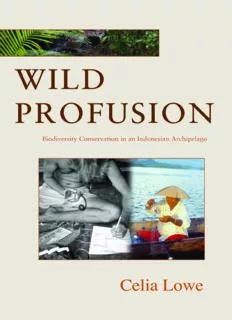
Wild Profusion: Biodiversity Conservation in an Indonesian Archipelago PDF
Preview Wild Profusion: Biodiversity Conservation in an Indonesian Archipelago
Wild Profusion SeriesEditor PaulRabinow Alistoftitlesintheseriesappearsatthebackofthebook Wild Profusion BIODIVERSITY CONSERVATION IN AN INDONESIAN ARCHIPELAGO Celia Lowe PRINCETON UNIVERSITY PRESS PRINCETON AND OXFORD Copyright©2006byPrincetonUniversityPress PublishedbyPrincetonUniversityPress,41WilliamStreet,Princeton,NewJersey08540 IntheUnitedKingdom:PrincetonUniversityPress,Oxford AllRightsReserved LibraryofCongressCataloging-in-PublicationData Lowe,Celia,1961– Wildprofusion:biodiversityconservationinanIndonesianarchipelago/CeliaLowe. p. cm.—(In-formationseries) Includesbibliographicalreferences(p.) ISBN-13:978-0-691-12461-2(cl:alk.paper) ISBN-10:0-691-12461-2(cl:alk.paper) ISBN-13:978-0-691-12462-9(pbk.) ISBN-10:0-691-12462-0(pbk.) 1.Biologicaldiversityconservation—Indonesia—TogianIslands.2.Biologicaldiversity conservation—Indonesia—Togian Islands—Social aspects. I. Title. II.In-formation series (PrincetonUniversity). QH77.I5L69 2006 333.95′1609598—dc22 2006041598 BritishLibraryCataloging-in-PublicationDataisavailable ThisbookhasbeencomposedinSabon Printedonacid-freepaper.∞ pup.princeton.edu PrintedintheUnitedStatesofAmerica 1 3 5 7 9 10 8 6 4 2 CONTENTS Preface vii Acknowledgments xiii ListofAbbreviations xvii INTRODUCTION BetweentheHumanandtheWildProfusion 1 PART ONE Diversity as Milieu 27 CHAPTERONE MakingtheMonkey 33 CHAPTERTWO TheSocialTurn 53 PART TWO Togean Cosmopolitics 75 CHAPTERTHREE ExtraterrestrialOthers 81 CHAPTERFOUR Onthe(Bio)logicsofSpeciesandBodies 106 PART THREE Integrating Conservation and Development 129 CHAPTERFIVE FishingwithCyanide 135 CHAPTERSIX TheSleepofReason 154 Appendix:Scientific,Military,andCommercialExplorations intheTogeanIslandsandVicinity:1680–1999 167 Notes 171 References 181 Index 193 PREFACE AS I DEPARTED for the last time from the Togean Islands of Central Su- lawesi,inAugustof1997,thesunwasbloodredandthehorizonenvel- opedbyasmokyhaze.Indonesiawasburning.Itwasthedryseason,but this would be like no dry season ever before. Over the ensuing months, the dense haze would form a cloud of smoke across Southeast Asia as wideandbroadasthefootprintoftheUnitedStates.FiresofthatElNin˜o yearwouldcauseplanestocrashandshipstorunaground,harmpublic health, destroy property and livelihoods, deplete biodiversity, and force PresidentSuhartotoissueapublicapologytoIndonesia’sSoutheastAsian neighbors.Thisdryseasonwouldprovetobeanunprecedentedenviron- mentaldisasterforIndonesia. Many different explanations for the fires emerged (Colfer 2002; Har- well2000).Forthemostpart,thestatepursueditsconventionalstrategy ofblamingswiddenagriculturalistsandsubsistencefarmersfordegrading the land and igniting the flames. Sometimes it was suggested that the sparks necessary to start the fires were caused by trees rubbing together orbylighteningbolts.Authoritiesdeclaredthatanyonewhoattributeda cause to the fires other than the unusual El Nin˜o was a “Communist,” whicheffectivelypreventedthemediafromspeculatingonalternativeex- planations.Somenationalistswantedtoblameforeigncorporations,de- spite the fact that foreign investors in the Indonesian forestry sector all had domestic allies, including President Suharto’s own family and busi- nesspartners. Butanunprecedentedtriumphalsoemergedoutofthesmokeandash: Indonesiannongovernmentalorganizations(NGOs)wereabletocounter the state’s rhetoric that blamed the devastation on small-scale farmers, therubbingoftree-limbs,foreigners,andtheweather.Forthefirsttime, activistswereabletomakethecasethatthefireswerecomingfromstate- owned forests and oil palm plantations and were a consequence of the government’s own forest conversion policies. They made this argument byappropriatingthenewscientifictechnologyofGeographicInformation Systems (GIS), pinpointing the exact locations of the fires and mapping theselocations ontostate andcommercialproperties. Producedthrough “science,”thesatelliteimageswerepoliticallyunassailable,andtheIndo- nesianForumfortheEnvironment(Walhi)wasabletousethemtobring lawsuitsagainstloggingcorporationsdespitethestatusandpowerofthe majoractorsinvolvedinforestconversionandtimberharvesting. WildProfusiontellsthestoryofatime(thedecadeculminatinginthe firesof1997–98)whentheIndonesianenvironmenthadbecomeapoint viii PREFACE ofconcernforsocialandenvironmentalactivists,scientists,andformany fishersandfarmersacrossthecountrywhoweresufferingfrombothde- gradedenvironmentsandfromaccusationsthattheywereresponsiblefor destroyingnature.MynarrativeapproachesthestatusofIndonesianland and marinescapes through one specific framing of nature: biodiversity. Biodiversity, in 1990s Indonesia, implied a particular assemblage of na- ture,nation,science,andidentity—makingIndonesians’mappingofthe concept distinct within the transnational biodiversity practices and dis- coursescirculatingwidelyatthetime.Aswiththefires,Indonesia’sgreat- estenvironmentaldisaster,biodiversitylossentailscomplexstrugglesover responsibilityandblame,financeandprofit,technoscience,nationalism, culturalandethnicdiversity—evenoverthenatureofnatureitself. In Wild Profusion I tell of Indonesian scientists and their efforts to documentthespeciesoftheTogeanIslands,toeconomicallyandsocially “develop” Togean people, and to turn the archipelago into a new na- tional park. These elite Indonesians sought to produce a biological sci- encethatwasbothinternationallyrecognizableandpoliticallyeffective in theIndonesian context inorder toincite positive socialand environ- mentaloutcomes. At the same time, I describe experiences of Togean people, especially people of Sama ethnicity. Sama and other Togean residents, as marginal Indonesian citizens, were often blamed for destroying the environment, despitethefactthatwell-connectedentrepreneursandstatedevelopment projects were responsible for the major transformations in Togean land andmarinescapes.Togeanpeoplehadtheirownunderstandingsofnature and nation, however, and stories of nature-making can also be narrated fromtheirperspectives. WildProfusionislikewiseastoryofTogeannature.Itdetailschanges in Togean land and marinescapes, and contests over what should count assignificantorvaluableformsofnatureforTogeanpeoples,tradersand bureaucrats,tourists,andinternationalanddomesticbiologists.Ittracks nature’sabilitytoshiftits“nature”dependingonwhoisdoingtheobserv- ing.Andittakesseriouslythedeclineinspeciesdiversityandabundance onaglobalscale. IbegantostudytheintersectionofIndonesians’conservationbiology, Samalives,andTogeannaturein1993.Myinitialapproachtothiscon- vergence was shaped by my background in political ecology and in the criticalperspectivesofwhatanthropologistswerecallingthena“culture andpoliticaleconomy”school.Inthe1990ssuchanapproachprovided a clear formula for determining winners and losers in the transnational politicaleconomy.Suchanalysesofbothenvironmentalismandeconomic developmentpreparedmewellto:first,recognizehowconservationand developmentregimeshavetendedtosubstituteabeliefinpurenatureand PREFACE ix instrumental rationality for others’ natures and ideas; second, see how theseregimescanextendthepowerofthestatethroughcoercivepractices ofculturalandeconomicmystification;andthird,torecognizetheways economicdevelopmentprogramscontinuallyfailtoimprovehumanwel- farewhileconservationinitiativesarehardlyeverabletosavenature. Once Iwas inIndonesia, however,this theoreticalbackground placed meinaquandary.Whileatfirstitwasdifficulttoseeanythingelseinthe Togeanprojectbutpoliticalandeconomicinjusticeinmanyforms,Iwas alsodevelopingacertainfriendshipwith,andanthropologicalloyaltyto, the scientists and activists whose work I was following. These scientists were deeply committed to their program of conservation and develop- ment, and saw their work as a point of hope for the nation. Moreover, one of the very first things I discovered in Indonesia was that scientists werequitesensitivetocriticismfromforeignscholarsandwerecontinu- ally evaluating me as to what kind of person I was: was I the type of foreign scholar who wanted to tell them how they had it all wrong, or could I also learn from them and value their contributions? How was I tomaintainmyanalyticperspectiveonthepoliticallogicsofconservation anddevelopment,andsimultaneouslycontinuetoshareanempathicrela- tionship with Indonesian scientists who believed that conservation biol- ogy and projects of economic development would contribute to the ad- vancementoftheirnation? ItwasultimatelymyIndonesiancolleaguesthemselveswhotaughtme toseetheirworkinanewlight.Intheirquestioningofmyunderstanding ofconservation,andintheirreadingofmytheoriesascriticismofthem (as individuals and as a national community), it became clear that the problemofhowtoholdthesituatednessofIndonesian’sscienceinsimul- taneoustensionwiththequestionsofjusticeraisedbyTogeanconserva- tion was central to my work and should be explored rather than deli- catelyavoided.IwouldneedtofindawaytotakeIndonesianscientists andtheirTogeanworkseriously,whileretainingmyawarenessthatbio- diversityconservationwascapableoffurthermarginalizingTogeanpeo- ple and their ability to live within the natures and histories they them- selvessustained. My desire simultaneously tounderstand scientists’ and Sama peoples’ perspectives onTogean natures,even whenthey werein conflict,led me down an empirical path marked by an increased attention to the details ofbiologyandconservationIwitnessed,andbynoticingdifferencesnot onlybetween,butwithin,thecategories“Sama”and“Indonesianscien- tist.” In the realm of theory, this practice led me to new literatures in science and technology studies and in postcolonial theory. The ethno- methodological approach of recent science and technology studies has helpedmetotrackthemicropracticesofbothscientistsandSamapeople
Description: